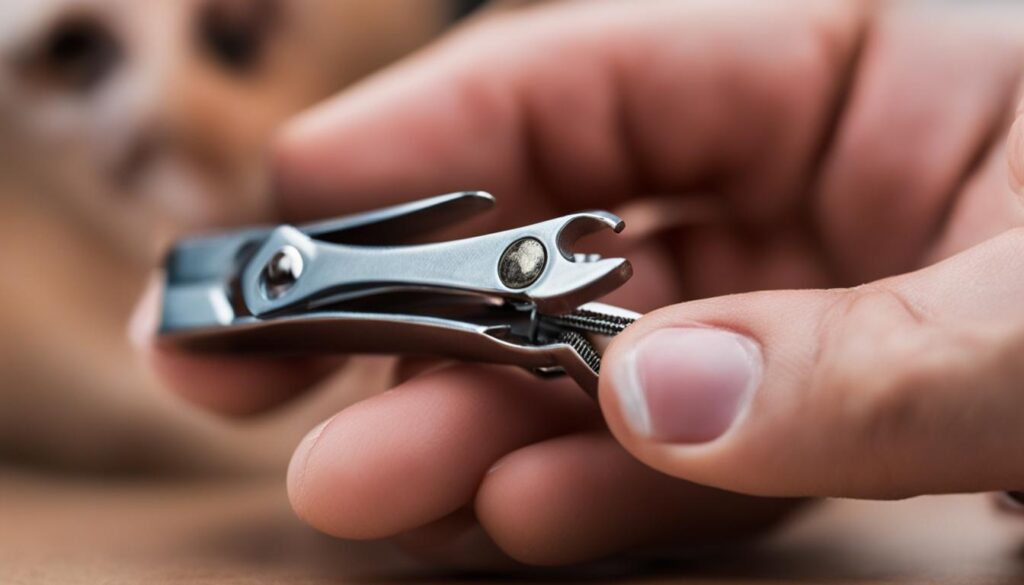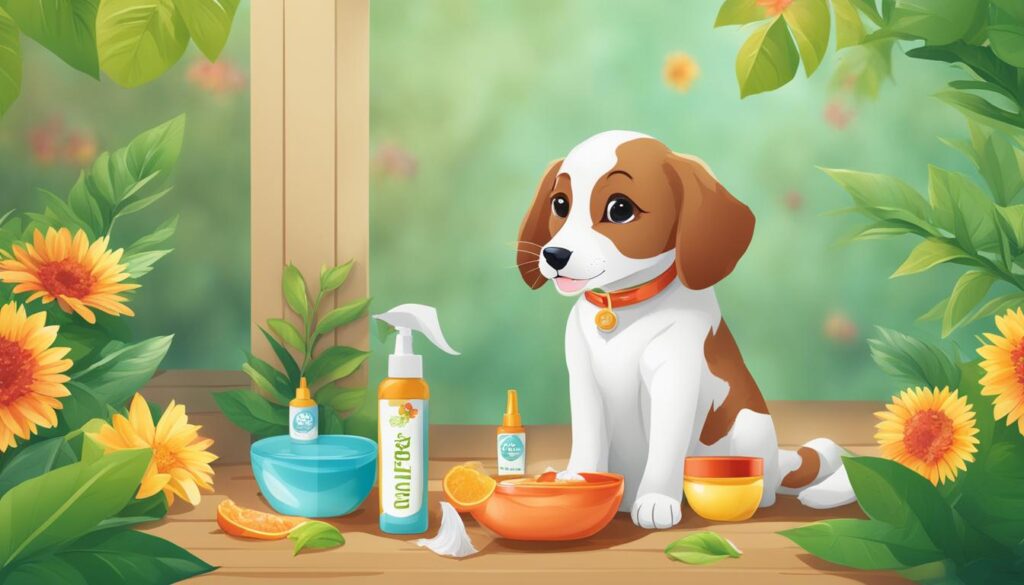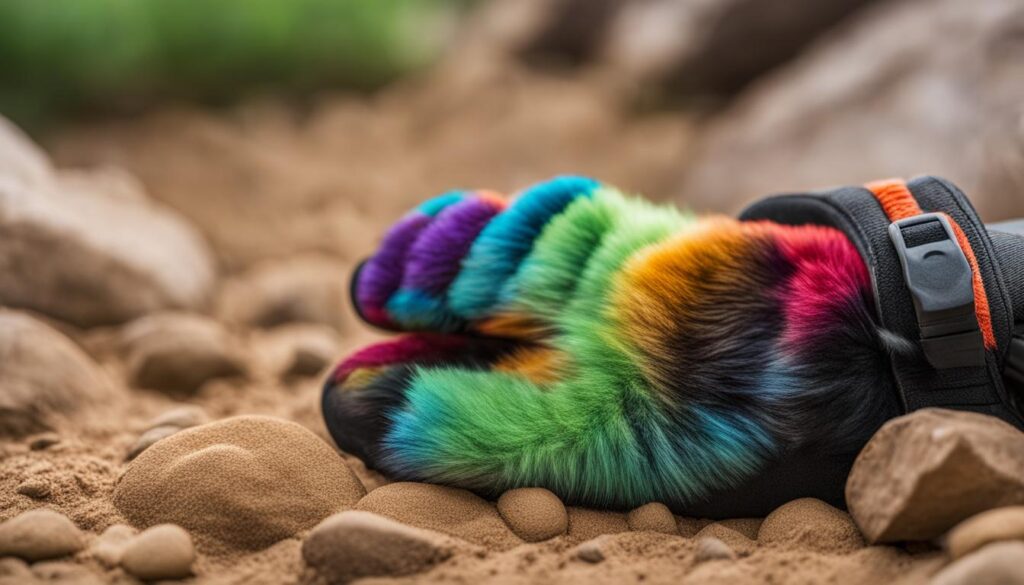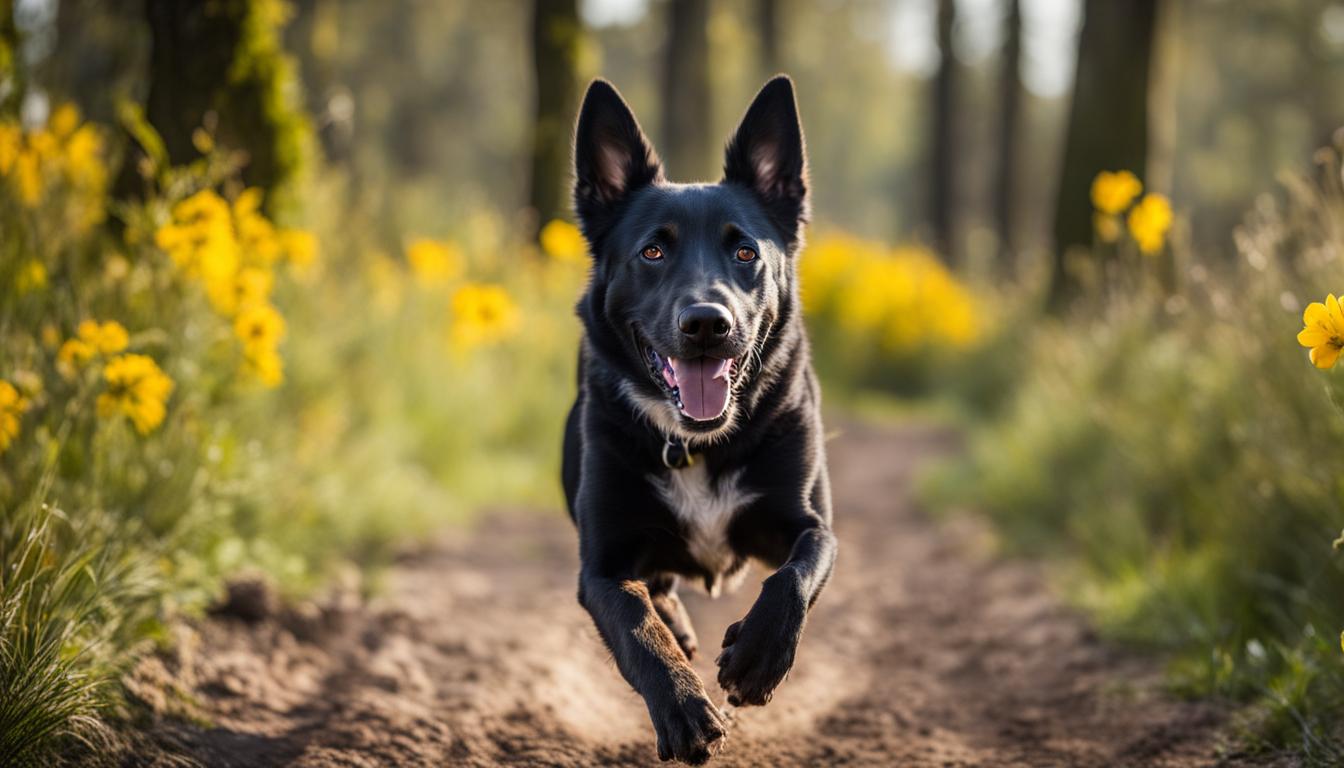As a pet owner, I know how important it is to prioritize the health and well-being of our furry companions. Alongside a nutritious diet and regular exercise, caring for our pets’ paws is crucial for their overall comfort and happiness. Whether it’s understanding the structure of their paws or taking preventive measures to keep them safe, it’s essential to have the right knowledge and guidance to ensure optimal paw health.
In this comprehensive guide, I will provide you with valuable tips and advice on how to care for your pet’s paws effectively. From routine inspections and proper grooming techniques to protecting their paws from seasonal dangers, we’ll cover it all to ensure your furry friend’s paws stay healthy and pain-free.
Key Takeaways:
- Regularly inspect your pet’s paws for foreign objects and potential injuries.
- Keep your pet’s nails properly trimmed to avoid discomfort and paw-related issues.
- Protect their paws from seasonal dangers such as hot pavement or icy surfaces.
- Maintain proper paw hygiene and moisture balance to prevent dryness or infections.
- Adapt exercise routines to ensure paw safety and gradually condition their paws for new activities.
Understanding Your Pet’s Paw Structure
To effectively care for your pet’s paws, it’s important to understand their paw structure. A pet’s paw consists of skin, bones, tendons, connective tissue, and blood vessels. The paw pads, made of fats and elastic fibers, serve multiple functions, including cushioning joints, protecting tissues, and temperature regulation.
By understanding the anatomy of your pet’s paws, you can better identify potential issues and provide appropriate care.
The Significance of Regular Paw Inspections
Regular paw inspections are crucial for maintaining your pet’s paw health. By conducting regular inspections, you can identify and address potential issues before they escalate. There are several key aspects to focus on during these inspections, including:
Identifying and Removing Foreign Objects
During paw inspections, it’s important to check for any foreign objects that may have become lodged in your pet’s paws. These can include pebbles, thorns, or debris picked up during outdoor activities. If left untreated, these objects can cause discomfort, pain, or even lead to infections. Promptly identifying and removing any foreign objects can help prevent such issues.
Assessing for Injuries and Allergies
Regular paw inspections allow you to assess your pet’s paws for any signs of injuries, such as cuts, scrapes, or swelling. By identifying these issues early on, you can provide the necessary care and prevent further complications. It’s also essential to be mindful of any signs of allergies, irritation, or inflammation on your pet’s paws, as these can indicate underlying issues that require attention.
Paw Cleaning Essentials Post-Outdoor Activities
After your pet engages in outdoor activities, it’s vital to clean their paws thoroughly. This helps remove dirt, allergens, and debris that may have accumulated. Regular paw cleaning reduces the risk of infections and irritation, ensuring your pet’s paws stay healthy and comfortable. Remember to use pet-safe products and gently dry their paws after cleaning.
https://www.youtube.com/watch?v=PWXCALDFpwE
Regular paw inspections, foreign object removal, paw injury assessment, and paw cleaning are essential components of proper paw care. By incorporating these practices into your routine, you can help maintain your pet’s paw health and prevent potential issues.
Trimming Nails and Fur for Optimal Paw Health
Trimming your pet’s nails and grooming the fur on their paws is essential for maintaining their overall paw health. By following proper techniques and frequencies, you can prevent discomfort, injuries, and other related issues. Regular nail trimming and paw fur maintenance promote cleanliness, hygiene, and optimal paw health.
Proper Nail Clipping Techniques and Frequency
When it comes to nail trimming, it’s important to use the correct techniques and trim them at the appropriate frequency. Here are some tips:
- Use high-quality nail clippers specifically designed for pets.
- Ensure proper lighting and a calm environment to minimize stress for your pet.
- Trim the nails gradually, taking small amounts off at a time to avoid cutting into the quick, which is the sensitive inner part of the nail.
- Consult with your veterinarian or a professional groomer for guidance on the ideal nail trimming frequency for your pet based on their breed, activity level, and nail growth rate.

The Importance of Keeping Paw Fur Trimmed
In addition to nail care, grooming the fur on your pet’s paws is equally important for optimal paw health. Here’s why:
- Trimming the paw fur helps prevent matting, which can cause discomfort and skin issues.
- Long paw fur can accumulate dirt, debris, and allergens, leading to irritation and potential infections.
- Excess fur between the paw pads can affect your pet’s grip and stability, especially on slippery surfaces.
- Regular paw fur grooming promotes cleanliness, minimizes paw odor, and ensures your pet’s overall paw hygiene.
By incorporating regular nail trimming and paw fur grooming into your pet’s grooming routine, you can contribute to their overall paw health and well-being.
Protecting Your Pet’s Paws from Seasonal Dangers
Each season brings its own set of challenges for your pet’s paws. From scorching hot pavement in the summer to icy surfaces in the winter, it is crucial to take proactive measures to protect their delicate paws from seasonal dangers. By following these tips and precautions, you can ensure that your pet’s paws remain safe and comfortable throughout the year.
“Protecting your pet’s paws from seasonal dangers is essential to their overall well-being. As a responsible pet owner, it’s important to be aware of the potential risks associated with different seasons and take appropriate actions to mitigate them.”
Summer Precautions
During the summer months, the pavement can become extremely hot and cause burns to your pet’s paws. To protect them from this seasonal danger:
- Avoid walking your pet during the hottest parts of the day when the pavement is at its peak temperature.
- Opt for walks on grass or shaded areas, where the ground is cooler.
- Consider using protective booties specifically designed to shield your pet’s paws from hot surfaces.
Winter Precautions
When winter arrives, the cold weather and icy surfaces pose a threat to your pet’s paws. To keep their paws safe and comfortable during this season:
- Limit the amount of time your pet spends outdoors in extremely cold temperatures.
- Invest in booties or paw wax to provide extra insulation and protection against freezing surfaces.
- Wipe your pet’s paws with a warm towel after walks to remove any salt, deicers, or ice balls that may have accumulated.
Year-Round Precautions
Regardless of the season, there are general precautions you can take to protect your pet’s paws:
- Regularly inspect your pet’s paws for any signs of irritation, cuts, or foreign objects.
- Keep their nails trimmed to prevent them from getting snagged or injured.
- Moisturize their paw pads with pet-safe moisturizers to prevent dryness and cracking.
- Consider using paw balms or ointments to provide an extra layer of protection against harsh weather conditions.
By implementing these seasonal paw safety measures, you can ensure that your furry friend’s paws stay healthy and comfortable all year round.
Pet Health and Wellness Tips: Paw Care Edition
In addition to proper paw care, there are various health and wellness tips that contribute to your pet’s overall well-being. Taking a holistic approach to pet care ensures that your furry friend thrives in all aspects of their health, from nutrition to exercise and preventive measures.
To keep your pet in optimal health, consider the following tips:
- Nutrition: Provide a balanced diet that meets your pet’s specific nutritional needs. Consult with a veterinarian to determine the appropriate food and portion sizes for your pet’s age, breed, and health condition.
- Exercise: Regular physical activity is essential for your pet’s overall fitness and mental well-being. Engage in age-appropriate exercise routines, such as daily walks, play sessions, or agility training, to keep your pet active and happy.
- Preventive Measures: Maintain regular veterinary check-ups to ensure your pet receives necessary vaccinations and preventive treatments, such as flea and tick control. Additionally, consider spaying or neutering your pet to prevent certain health issues.
- Oral Health: Dental hygiene is crucial for your pet’s overall well-being. Brush their teeth regularly using pet-friendly toothpaste, and provide appropriate chew toys to promote oral health.
- Mental Stimulation: Engage in interactive play sessions and provide mental stimulation activities, such as puzzle toys or treat-dispensing toys, to keep your pet’s mind sharp and prevent boredom.
- Stress Management: Implement stress-reduction techniques, such as creating a calm and safe environment and providing comforting routines, to help your pet manage stress and anxiety.
By incorporating these pet health and wellness tips into your routine, you can ensure that your pet not only has healthy paws but also enjoys a happy and thriving life.

Maintaining Paw Hygiene and Moisture Balance
Choosing the Right Products for Your Pet’s Paws
Maintaining proper hygiene and moisture balance is essential for your pet’s paw health. Ensuring that your pet’s paws are clean and moisturized helps prevent infections, dryness, and discomfort. When choosing products for your pet’s paws, consider their specific needs and sensitivities. Look for pet paw products that are specifically formulated for cleaning and moisturizing, and avoid using products that may contain harsh chemicals or irritants.
| Product Type | Benefits |
|---|---|
| Paw Cleaning Wipes | Convenient and easy-to-use for quick paw cleaning on-the-go. They help remove dirt, allergens, and debris. |
| Paw Wash Solutions | Gentle and effective for thorough cleaning. They are designed to remove bacteria and odors without drying out the paws. |
| Paw Balms | Provide moisturizing and protection for dry and cracked paws. They soothe and nourish the paw pads, promoting healing and preventing further damage. |
When selecting pet paw products, read the labels carefully and choose ones that are specifically designed for your pet’s species and paws. It’s also a good idea to consult with your veterinarian if you have any concerns or if your pet has pre-existing conditions that may require specialized products.
Signs of Excessive Dryness and Remedies
Excessive dryness in your pet’s paws can lead to discomfort and potential issues such as cracking, bleeding, or infections. It’s important to be aware of the signs of dryness and take appropriate measures to address them. Some common signs of excessive dryness in pet paws include:
- Visible cracks or flaking skin
- Bleeding
- Redness or inflammation
- Limping or reluctance to walk
If you notice any of these signs, it’s important to provide your pet with the necessary remedies to alleviate the dryness and promote healing. Here are some dry paw remedies you can try:
- Moisturizing paw balms or creams: Apply a pet-friendly moisturizing balm or cream to the affected areas of your pet’s paws. These products provide hydration and create a protective barrier.
- Pet-safe oils: Some natural oils, such as coconut oil or olive oil, can help moisturize and soothe your pet’s dry paws. Apply a small amount and gently massage it into the paw pads.
- Regular paw soaking: Soaking your pet’s paws in a warm water and salt solution can help relieve dryness and promote healing. Be sure to dry the paws thoroughly after soaking.
Remember to monitor your pet’s paws regularly and seek veterinary attention if the dryness persists or if you notice any signs of infection.
First Aid for Paw Injuries
Accidents happen, and in the event of a paw injury, knowing the proper first aid techniques is crucial. Whether it’s a cut, scrape, or puncture wound, taking immediate action can make a significant difference in your pet’s recovery. Here are some essential steps to follow when providing first aid for paw injuries:
- Assess the injury: Carefully examine your pet’s paw to determine the extent of the injury. Look for any signs of bleeding, swelling, or visible foreign objects.
- Clean the wound: Using a clean cloth or gauze pad, gently wipe away any dirt or debris from the injured area. If possible, rinse the paw with lukewarm water to further cleanse the wound.
- Apply pressure: If the wound is bleeding, apply gentle pressure with a clean cloth or bandage to help stop the bleeding. Avoid applying excessive pressure that may cause further discomfort.
- Dress the wound: Once the wound is clean and the bleeding has stopped, apply a pet-safe antiseptic or wound dressing. This helps prevent infection and promotes healing. If necessary, you can cover the dressing with a breathable bandage or wrap to protect the paw.
- Monitor for signs of infection: Keep a close eye on the injured paw for any signs of infection, such as redness, swelling, discharge, or increased pain. If you notice any concerning symptoms, consult your veterinarian promptly.

Remember, while first aid for paw injuries is essential, it’s crucial to seek veterinary care for more severe wounds or if you’re uncertain about the best course of action. Your veterinarian can provide further guidance and ensure that proper treatment is administered.
Preventive Measures for Long-Term Paw Health
Taking preventive measures is essential for your pet’s long-term paw health. By implementing these measures, you can ensure that their paws are protected from potential hazards and maintain their overall well-being. Two essential preventive measures for paw health are opting for protective footwear and regularly assessing play areas for safety.
Opting for Protective Footwear

Protective footwear is an excellent way to shield your pet’s paws from rough terrain, extreme temperatures, and harmful substances. These specially designed shoes provide a layer of protection to prevent injuries and discomfort. When selecting protective footwear, ensure the shoes are the right fit and comfortable for your pet. By choosing the appropriate footwear, you can give your pet the freedom to explore without compromising their paw health.
Environment Assessment: Keeping Play Areas Safe
Regularly assessing your pet’s play areas is crucial for creating a safe environment for their paws. Inspect the area for any potential hazards such as sharp objects, toxic substances, or uneven surfaces that may cause injuries or irritation. Remove any dangerous items and make necessary adjustments to create a safe and secure play area for your pet. By doing so, you can minimize the risk of paw-related accidents and ensure your pet can play and roam freely without harm.
Adapting Exercise Routines for Paw Safety
Exercise plays a vital role in maintaining your pet’s overall well-being and energy levels. However, it’s important to adapt exercise routines to ensure paw safety and avoid potential injuries. By understanding the impact of different surfaces on your pet’s paws and gradually conditioning their paws for new activities, you can help protect them and promote paw strength.
Understanding the Impact of Different Surfaces
Different surfaces can have varying effects on your pet’s paws. Hard surfaces like concrete or pavement can be tough on their pads and potentially cause abrasions or discomfort. On the other hand, soft surfaces like grass or sand provide better cushioning and are generally gentler on their paws.
When planning exercise routines, consider the surfaces your pet will be walking or running on. If you’ll be exercising outdoors, choose routes that have softer surfaces and avoid hot asphalt or icy terrain. If necessary, invest in booties or protective footwear to provide extra cushioning and prevent injuries.
Conditioning Paws for New Activities
Introducing your pet to new activities gradually is essential for paw safety. Just as we warm up before exercising, it’s important to condition your pet’s paws for new activities to avoid strain or injuries.
Start by gradually increasing the intensity and duration of the activity, allowing their paws to adjust to the increased demands. Regularly check their paws for any signs of irritation or discomfort, such as redness or limping, and adjust the activity level accordingly.
It’s also beneficial to engage in paw-specific exercises that promote paw strength, such as paw massages, gentle paw squeezes, or walking on textured surfaces. These exercises can help build paw resilience and reduce the risk of injuries during physical activities.
| Paw Conditioning Tips | Benefits |
|---|---|
| Gradually increase exercise intensity and duration | Helps paws adjust to increased demands and reduces the risk of strain or injuries |
| Engage in paw-specific exercises | Builds paw strength and resilience, minimizing the risk of injuries during physical activities |
| Regularly check paws for signs of irritation or discomfort | Allows for prompt adjustments to the activity level, ensuring paw safety |
Natural and Holistic Approaches to Paw Care
When it comes to caring for your pet’s paws, natural and holistic approaches can offer numerous benefits. By incorporating home remedies and holistic paw care products into your pet’s routine, you can enhance their paw health without relying on harsh chemicals or additives.
Home Remedies for Paw Care
There are various home remedies that can alleviate common paw issues and provide relief for your pet. Here are a few natural remedies to consider:
- Coconut oil: Applying coconut oil to your pet’s paws can help combat dryness and provide moisture.
- Chamomile tea soak: Soaking your pet’s paws in chamomile tea can soothe irritation and reduce inflammation.
- Aloe vera gel: Aloe vera gel can be applied topically to soothe paw pads and promote healing.
- Oatmeal bath: An oatmeal bath can relieve itching and irritation caused by allergies or insect bites.
It’s important to remember that not all home remedies may be suitable for your pet, so it’s best to consult with a veterinarian before trying any new treatments.
Benefits of Holistic Paw Care Products
Holistic paw care products offer several advantages for your pet’s paw health:
- Natural ingredients: Holistic products are often made with natural ingredients that are gentle on your pet’s paws.
- No harsh chemicals: These products are free from harsh chemicals, reducing the risk of irritation or allergic reactions.
- Moisturizing properties: Holistic paw care products are designed to moisturize and nourish your pet’s paws, promoting overall paw health.
- Support for specific conditions: There are holistic products available to address specific paw issues, such as cracked paw pads or excessive dryness.
When choosing holistic paw care products, always read the labels and opt for those that are formulated specifically for pets. Additionally, it’s recommended to consult with your veterinarian to ensure the products are suitable for your pet’s individual needs.
Conclusion
In conclusion, taking care of your pet’s paws is crucial for their overall health and well-being. By following the tips and advice provided in this comprehensive guide, you can ensure that your pet’s paws remain healthy, comfortable, and free from common issues.
Remember to prioritize regular inspections of your pet’s paws to identify and remove any foreign objects promptly. Assess for injuries or allergies, and ensure proper paw cleaning after outdoor activities to reduce the risk of infection and irritation.
Trimming your pet’s nails and keeping their paw fur trimmed is essential for optimal paw health. It’s also important to protect your pet’s paws from seasonal dangers by taking precautions during different weather conditions.
Additionally, maintaining paw hygiene and moisture balance is crucial. Choose the right products for cleaning and moisturizing your pet’s paws, and be aware of signs of excessive dryness. In the event of a paw injury, knowing first aid techniques can make a significant difference in your pet’s healing process and comfort.
Lastly, adopting preventive measures and adapting exercise routines will contribute to your pet’s long-term paw health. Consider protective footwear, assess play areas for hazards, and gradually condition your pet’s paws for new activities.
By implementing these final paw care tips, you can provide your pet with the care they need to keep their paws healthy, comfortable, and ready for all the adventures ahead.
FAQ
What is the structure of a pet’s paw?
A pet’s paw consists of skin, bones, tendons, connective tissue, and blood vessels. The paw pads, made of fats and elastic fibers, serve multiple functions, including cushioning joints, protecting tissues, and temperature regulation.
Why are regular paw inspections important?
Regular paw inspections are important for maintaining your pet’s paw health. They allow you to identify and remove foreign objects, assess for injuries and allergies, as well as clean the paws after outdoor activities to reduce the risk of infection and irritation.
How often should I trim my pet’s nails and paw fur?
Nail trimming should be done regularly, depending on your pet’s activity level and nail growth. Trim the paw fur as needed to prevent matting, dirt accumulation, and related issues.
How can I protect my pet’s paws from seasonal dangers?
Different seasons present unique challenges for your pet’s paws. Protect them from hot pavement in the summer and icy surfaces in the winter. Take precautions such as using paw wax or boots to shield their paws from extreme temperatures and harmful substances.
What are some holistic approaches to pet care?
Holistic pet care involves considering your pet’s overall well-being. This includes providing proper nutrition, exercise, and preventive measures to ensure your pet thrives in all aspects of their health.
How can I maintain proper hygiene and moisture balance for my pet’s paws?
Choose suitable products for cleaning and moisturizing your pet’s paws. Regularly inspect for signs of excessive dryness, such as cracking or bleeding, and use remedies to alleviate these issues.
What should I do in case of a paw injury?
In the event of a paw injury, it’s important to provide appropriate first aid. Clean and dress the wound, prevent infection, and ensure proper care for your pet’s injured paws. Prompt and correct first aid can aid in the healing process and reduce discomfort.
How can I take preventive measures for my pet’s paw health?
Consider using protective footwear to shield their paws from rough terrain, extreme temperatures, and harmful substances. Regularly assess their play areas for potential hazards and make necessary adjustments to create a safe environment for their paws.
How can I adapt exercise routines for my pet’s paw safety?
Understand how different surfaces can affect your pet’s paws and adjust activities accordingly. Gradually condition their paws for new activities to protect against injuries and promote paw strength.
Are there natural and holistic approaches to paw care?
Yes, there are natural alternatives and home remedies that can alleviate common paw issues. Additionally, there are holistic paw care products available that offer the benefits of natural ingredients without harsh chemicals or additives.
Source Links
- https://www.webmd.com/pets/dogs/paw-care-tips-dogs
- https://www.preventivevet.com/dogs/how-to-properly-care-for-your-dogs-paw-pads
- https://www.skylineanimalclinic.net/site/blog/2022/05/16/healthy-dog-paw-tips

